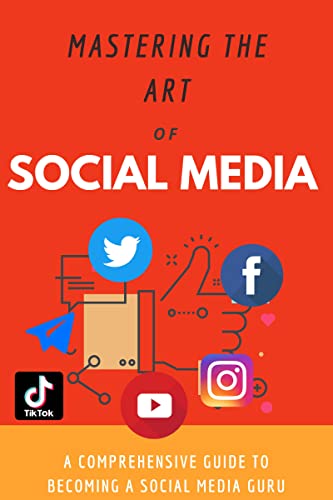Are you tired of struggling to find success with your social media marketing efforts? Look no further! In this article, you will uncover the secrets to mastering the art of social media marketing strategy. We will guide you step by step through the process of developing a winning strategy that will drive engagement, boost brand awareness, and increase your online presence. Get ready to take your social media game to new heights and achieve the results you’ve always dreamed of.
1. Defining Social Media Marketing Strategy
1.1 What is social media marketing?
Social media marketing refers to the use of social media platforms to promote products or services, enhance brand visibility, and engage with target audiences. It involves creating and sharing content, engaging in conversations, and building relationships with customers and prospects through social media channels such as Facebook, Instagram, Twitter, LinkedIn, and others.
1.2 Importance of developing a social media marketing strategy
Having a well-defined social media marketing strategy is essential for businesses of all sizes. It provides a roadmap for effectively utilizing social media platforms to achieve marketing goals, reach target audiences, and drive business growth. A strategic approach ensures that efforts on social media are focused, consistent, and aligned with the overall marketing objectives of the organization. Without a strategy, businesses run the risk of wasting resources, missing opportunities, and not maximizing the potential of social media for their brand.
1.3 Key components of a successful social media marketing strategy
A successful social media marketing strategy encompasses various components that work together to achieve desired outcomes. These key components include:
- Clear objectives: Setting clear, specific, measurable, attainable, relevant, and time-bound (SMART) objectives that align with the overall business goals.
- Identifying target audience: Gaining a deep understanding of the target audience’s demographics, interests, preferences, and behaviors to tailor social media efforts accordingly.
- Choosing the right social media platforms: Evaluating different platforms based on the target audience and business goals to select the most suitable ones.
- Crafting engaging content: Developing a content strategy and content calendar to create valuable, relevant, and shareable content that resonates with the target audience.
- Leveraging influencer marketing: Identifying and collaborating with relevant influencers to amplify brand messages and reach wider audiences.
- Effective community management: Monitoring and responding to comments and messages, encouraging user-generated content and engagement, and addressing customer concerns and feedback.
- Implementing data analytics: Tracking and measuring key social media metrics, utilizing analytics tools to gain insights, and optimizing strategies based on data.
- Staying up-to-date with industry trends: Following thought leaders, attending conferences, and regularly researching and experimenting with new social media marketing tactics.
- Adapting to algorithm changes: Understanding how social media algorithms work, adapting strategies to algorithm changes, and staying informed about updates from social media platforms.
2. Setting Clear Objectives
2.1 Identifying goals and objectives
Setting clear goals and objectives is the foundation of a successful social media marketing strategy. It involves determining what the business aims to achieve through social media efforts. Goals can vary from increasing brand awareness and driving website traffic to generating leads and increasing conversions. By clearly defining these goals, businesses can align their social media activities and measure their success.
2.2 Specific, measurable, attainable, relevant, and time-bound (SMART) objectives
To make objectives effective, they need to be SMART – specific, measurable, attainable, relevant, and time-bound. Specific objectives clearly outline the desired outcome, such as increasing social media followers by 20% in three months. Measurable objectives have quantifiable criteria, making it easier to track progress and evaluate success. Attainable objectives are realistic and within the capabilities of the business. Relevant objectives align with the overall marketing goals and target audience. Time-bound objectives have a specific timeframe for achievement, providing a sense of urgency and accountability.
2.3 Aligning objectives with overall business goals
It is crucial to align social media objectives with the overall business goals of the organization. By doing so, businesses ensure that their social media efforts contribute to the broader objectives and serve the long-term vision. For example, if the overall business goal is to increase sales by 20% in the next quarter, the social media objective could be to generate leads and drive conversions from social media platforms. Aligning objectives ensures that social media efforts are not isolated but integrated within the larger marketing strategy.

3. Understanding Target Audience
3.1 Identifying and defining a target audience
Understanding the target audience is vital for effective social media marketing. Businesses need to identify and define their target audience, gaining insights into demographics, interests, preferences, and behaviors. This knowledge helps tailor content, messaging, and social media strategies to resonate with the audience and address their needs and desires. Target audience identification can be done by analyzing customer data, conducting surveys, and leveraging market research tools.
3.2 Conducting market research
Market research plays a crucial role in understanding the target audience and their social media habits. It involves collecting and analyzing data about the market, competitors, and customers. Market research provides valuable insights into consumer trends, preferences, pain points, and motivations, helping businesses shape their social media strategies accordingly. Conducting market research can involve surveys, focus groups, interviews, and analyzing online discussions and social media conversations.
3.3 Developing buyer personas
Buyer personas are fictional representations of the target audience, created based on market research and data. They provide a detailed understanding of the target audience’s demographics, characteristics, motivations, goals, and challenges. Developing buyer personas helps businesses humanize their target audience and tailor social media content and strategies to meet their unique needs. By knowing who their ideal customers are, businesses can create highly targeted and engaging content that resonates with their audience on social media.
4. Choosing the Right Social Media Platforms
4.1 Evaluating popular social media platforms
There are numerous social media platforms available, each with its own unique features, user base, and purpose. It is essential for businesses to evaluate different platforms and understand their strengths and weaknesses. Platforms like Facebook, Instagram, Twitter, LinkedIn, YouTube, and Pinterest have varying demographics, reach, and engagement levels. By evaluating these platforms, businesses can determine which ones align with their target audience and marketing goals.
4.2 Analyzing target audience demographics
Analyzing the demographics of the target audience is crucial in choosing the right social media platforms. Different platforms attract different age groups, genders, and interests. For example, Instagram tends to have a younger audience, while LinkedIn caters to professionals and business-oriented individuals. By aligning the target audience demographics with platform demographics, businesses can ensure that their social media efforts are focused on platforms where their audience is most active.
4.3 Selecting platforms based on business goals and target audience preferences
Choosing the right social media platforms should be driven by a combination of factors, including target audience preferences and business goals. Businesses should consider the type of content they plan to create, the engagement levels they seek, and the specific features and capabilities of each platform. Additionally, it is important to assess the level of competition and the potential for organic reach on each platform. By selecting platforms that align with both the target audience’s preferences and the business goals, businesses can optimize their social media marketing efforts.

5. Creating Engaging Content
5.1 Crafting a content strategy
A content strategy outlines the types of content that will be created and shared on social media platforms. It involves defining the brand’s tone of voice, content themes, content formats, and frequency of posting. A well-crafted content strategy ensures consistency, relevance, and value in the content shared on social media. It helps businesses engage and connect with their target audience, foster brand loyalty, and achieve marketing objectives.
5.2 Developing a content calendar
A content calendar is a schedule that outlines when and where specific content will be posted on social media platforms. It helps businesses stay organized, plan ahead, and ensure a consistent flow of content. The content calendar takes into account important dates, holidays, and events that are relevant to the target audience. By developing a content calendar, businesses can create a balanced mix of content types, avoid repetition, and optimize the timing of their posts.
5.3 Tailoring content to suit each social media platform
While a consistent brand voice is important, it is equally crucial to tailor content for each social media platform. Each platform has its own unique features, character limits, and content formats. By adapting content to suit each platform, businesses can optimize engagement and reach. For example, visual content such as images and videos tend to perform well on platforms like Instagram and Pinterest, while informative articles and industry updates are better suited for LinkedIn.
6. Leveraging Influencer Marketing
6.1 Identifying relevant influencers in your industry
Influencer marketing involves collaborating with individuals who have a significant following and influence on social media. Identifying relevant influencers in your industry is crucial for amplifying brand messages and reaching a wider audience. Businesses can use research tools, social media listening, and industry networks to find influencers who align with their brand values and target audience.
6.2 Building relationships with influencers
Building relationships with influencers is essential for successful influencer marketing. This involves reaching out to influencers, engaging with their content, and building a rapport. Businesses can provide value to influencers by sharing their content, mentioning them in posts, and offering collaboration opportunities. By nurturing relationships with influencers, businesses can establish trust and credibility, which in turn helps in building brand awareness and reaching new customers.
6.3 Collaborating with influencers to amplify your brand message
Once relationships with influencers are established, businesses can collaborate with them to amplify their brand messages. This can be done through sponsored posts, reviews, giveaways, and content collaborations. Influencers can provide a unique perspective and voice to the brand, enabling businesses to tap into their audience and gain exposure to new potential customers. By leveraging influencer marketing, businesses can extend their reach, enhance brand credibility, and drive engagement on social media.

7. Effective Community Management
7.1 Monitoring and responding to comments and messages
Effective community management involves regularly monitoring and responding to comments and messages on social media platforms. Engaging with the audience shows that the business values their feedback and opinions. By responding promptly and genuinely, businesses can build stronger relationships, address customer concerns, and foster a sense of community. Monitoring tools and social media management platforms can help streamline and organize the process of community management.
7.2 Encouraging user-generated content and engagement
User-generated content (UGC) refers to content that is created and shared by customers or fans. Encouraging UGC is an effective way to increase engagement, showcase customer satisfaction, and build brand advocacy. Businesses can incentivize UGC by running contests, encouraging customers to share their experiences, or simply by showcasing user-generated content that aligns with their brand values. By actively involving the audience in content creation, businesses can foster a sense of belonging and connection to the brand.
7.3 Addressing customer concerns and feedback
Social media provides a platform for customers to voice their concerns, share feedback, and seek assistance. Effective community management involves promptly addressing and resolving customer concerns and feedback. By acknowledging customer complaints, offering solutions, and demonstrating empathy, businesses can strengthen their reputation, improve customer satisfaction, and build trust. Taking the time to address customer concerns publicly also showcases the brand’s commitment to customer service and engagement.
8. Implementing Data Analytics
8.1 Tracking and measuring key social media metrics
Data analytics plays a vital role in evaluating the success of social media marketing efforts. Tracking and measuring key social media metrics provide insights into the effectiveness of various strategies and tactics. Metrics such as engagement rate, reach, follower growth, website traffic, and conversions help businesses understand what is working and what needs improvement. By regularly analyzing these metrics, businesses can make data-driven decisions, optimize strategies, and allocate resources more effectively.
8.2 Utilizing social media analytics tools
Social media analytics tools provide businesses with the ability to track, measure, and analyze social media metrics in an organized and efficient manner. These tools collect and present data on audience demographics, engagement levels, content performance, and overall social media reach. By utilizing these analytics tools, businesses can gain deeper insights into their target audience, understand the effectiveness of their content, and refine their social media marketing strategies.
8.3 Identifying areas of improvement and optimizing strategies based on data
Data analytics help businesses identify areas of improvement and optimize social media strategies based on the insights gained. By analyzing data, businesses can identify content types that resonate well with the target audience, determine optimal posting times, and discover opportunities for engagement. Additionally, data analytics highlight areas where strategies may not be effective, allowing businesses to make necessary adjustments and test new approaches. Continuously optimizing strategies based on data helps businesses stay ahead of the competition, adapt to changing trends, and drive better results on social media.
9. Staying Up-to-Date with Industry Trends
9.1 Following industry thought leaders and publications
Staying up-to-date with industry trends is crucial in the ever-evolving world of social media marketing. Following industry thought leaders and publications provides insights into emerging strategies, best practices, and innovative approaches. Thought leaders often share valuable information, case studies, and predictions, helping businesses stay informed and inspired. By actively following industry experts and publications, businesses can keep their social media strategies relevant and adapt to the latest trends and techniques.
9.2 Attending conferences and webinars
Attending conferences and webinars focused on social media marketing is another effective way to stay up-to-date with industry trends. These events bring together industry experts, marketers, and thought leaders who share their experiences, knowledge, and insights. Conferences and webinars offer opportunities to learn about new tools, tactics, and success stories. By participating in such events, businesses can expand their network, gain valuable knowledge, and stay ahead of the curve in social media marketing.
9.3 Regularly researching and experimenting with new social media marketing tactics
Researching and experimenting with new social media marketing tactics is crucial for innovation and growth. The social media landscape is constantly evolving, and businesses need to adapt to new platforms, features, and trends. Regularly researching and experimenting with new tactics allows businesses to test different strategies, discover what works best for their audience, and stay ahead of competitors. By embracing experimentation and being open to change, businesses can unleash the full potential of social media marketing.
10. Adapting to Algorithm Changes
10.1 Understanding how social media algorithms work
Social media algorithms determine how content is prioritized, displayed, and distributed on platforms. Understanding how these algorithms work is essential for maximizing reach and engagement. Algorithms consider various factors like user preferences, engagement levels, recency, and relevance when deciding which content to show. By understanding the algorithms, businesses can tailor their content and posting strategies to align with the platform’s algorithmic preferences.
10.2 Adapting strategies to algorithm changes
Social media platforms frequently update and tweak their algorithms, which can have a significant impact on content visibility and engagement. It is crucial for businesses to stay informed about algorithm changes and adapt their strategies accordingly. For example, if a platform prioritizes video content, businesses should focus on creating and sharing more videos. Adapting strategies to algorithm changes ensures that businesses maintain visibility and reach on social media platforms.
10.3 Staying informed about algorithm updates from social media platforms
Staying informed about algorithm updates from social media platforms is essential for maintaining an effective social media marketing strategy. Social media platforms regularly communicate algorithm changes and updates through official announcements, blog posts, and updates in their platform algorithms. By staying updated and informed, businesses can proactively adapt their strategies, tweak their content, and ensure that their social media efforts continue to yield optimal results.
In conclusion, developing and implementing a comprehensive social media marketing strategy is crucial for businesses to effectively reach and engage with their target audience. By defining clear objectives, understanding the target audience, choosing the right platforms, creating engaging content, leveraging influencers, practicing effective community management, implementing data analytics, staying up-to-date with industry trends, and adapting to algorithm changes, businesses can establish a solid foundation for success in social media marketing.












